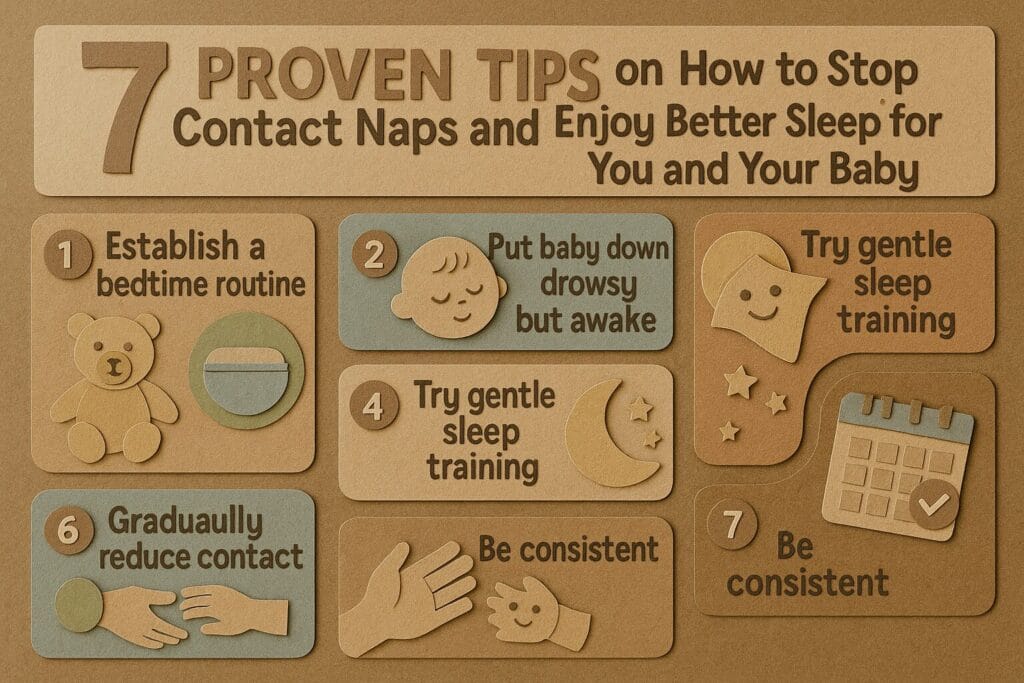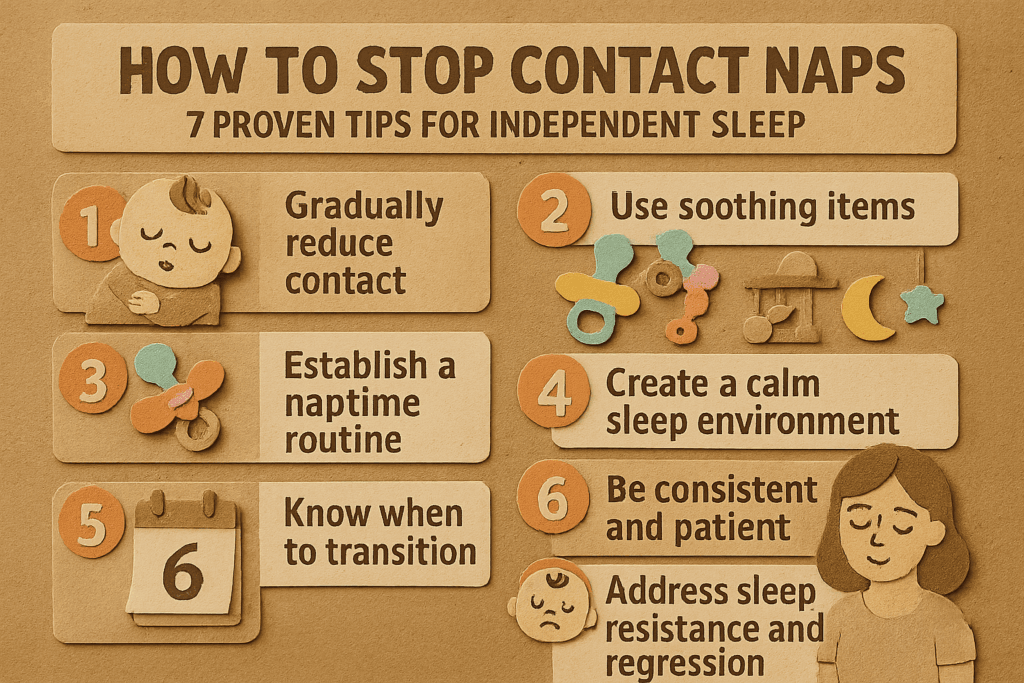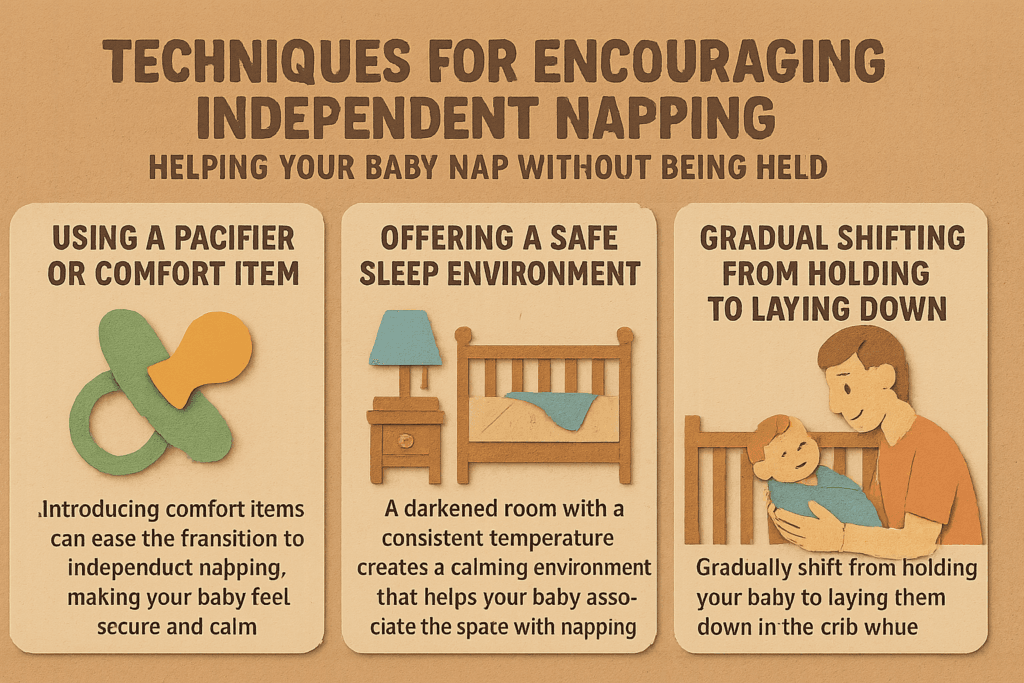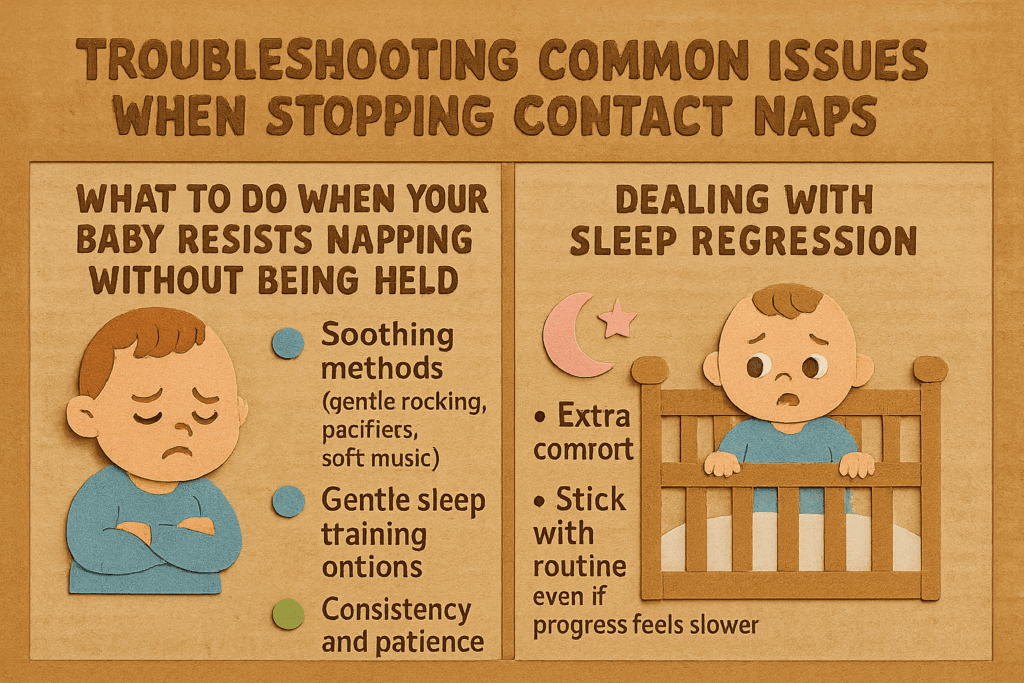
Introduction: Breaking the Cycle of Contact Naps
You’re not alone if you’re struggling with contact naps and wondering how to stop contact napping. Many parents begin with contact naps because they’re comforting and soothing for both the baby and the parent. However, this habit can create challenges over time that make it difficult for both of you to sleep independently. Understanding the impact of contact naps is the first step in successfully breaking the cycle.
Learning how to stop contact naps is key to fostering better sleep habits for both you and your baby. When babies depend on being held to nap, it can disrupt their sleep patterns and create dependency. Over time, this dependency can make it harder for babies to nap independently and for parents to get restful breaks during the day. It’s important to gradually transition your baby toward more independent sleep habits to benefit everyone in the family.
This guide will help you navigate how to stop contact naps with clear, step-by-step strategies. By using gentle methods to ease your baby into napping without being held, you can create a more predictable and healthy sleep routine. This transition will ultimately help your baby become a more independent sleeper while giving you back some personal time.
Table of Contents
Why Contact Naps Aren’t Sustainable

Although contact naps provide immediate comfort, they create a dependency that can hinder your baby’s ability to sleep independently. Babies who rely on being held for naps may have difficulty falling asleep or settling down when they wake up. Learning how to stop contact naps is crucial for teaching your baby self-soothing techniques and creating a sustainable sleep routine.
As babies grow, they need to learn how to nap in a crib or bassinet without needing to be held. This is important for their sleep development and their ability to fall asleep on their own at night. When you stop contact napping, you encourage your baby to develop more independence, leading to better sleep patterns for daytime and nighttime rest.
By breaking the cycle of contact naps, you’re also reclaiming valuable time for yourself. Being constantly tied to holding your baby for every nap can be exhausting. Learning how to stop contact naps will give you the opportunity to rest, get things done, or take a break while ensuring your baby is still napping safely and comfortably.
How This Guide Will Help You
In this article, we’ll walk you through clear, effective strategies for how to stop contact naps. The techniques we cover are gradual and gentle, allowing your baby to transition to independent naps without distress. You’ll learn how to set up a consistent routine, create a safe sleep space, and provide comforting alternatives, all of which will help your baby nap independently.
We’ll also address different stages in your baby’s development. Whether your baby is 3 or 6 months old, this guide will provide age-appropriate solutions. Transitioning from contact to independent naps may take some time, but your baby will adapt to a healthier sleep routine with patience and consistency.
Following the strategies in this guide, you can successfully stop contact naps and create a more sustainable and independent sleep routine for your baby. You’ll also feel empowered knowing that you and your baby are on the path to better sleep and well-being.
Why Understanding How to Stop Contact Naps Is Crucial
Before figuring out how to stop contact naps, it’s important to understand why they can be an issue for you and your baby. While contact naps are comforting, they can create long-term challenges.
The Pros and Cons of How to Stop Contact Naps
Contact naps provide comfort and closeness, which is great for bonding. Many parents enjoy the peaceful moments of holding their baby asleep. However, these naps can also disrupt your baby’s overall sleep schedule.
In the long run, contact napping can make it difficult for babies to nap independently. They might rely on being held as they grow, making naps less predictable. This can interfere with developing a consistent routine.
Furthermore, contact napping might make it harder for your baby to settle back to sleep after waking. If your baby is used to being held, they may find falling asleep on their own difficult. This could lead to restless nights for both of you.
While contact naps are often seen as an easy way to soothe your baby, they may also prevent your baby from learning how to self-soothe. This skill is important for their development and future sleep independence.
Ultimately, the comfort of contact naps must be balanced with the long-term goal of fostering healthy sleep habits for your baby.
Why You Should Learn How to Stop Contact Napping

Understanding how to stop contact naps is important for creating a more sustainable sleep routine for you and your baby. When babies depend on being held to sleep, it can be difficult for parents to find time for themselves.
Breaking the contact nap habit can improve your baby’s sleep schedule. Napping independently helps babies sleep more soundly and learn to settle independently. This transition can make it easier for both daytime naps and nighttime sleep.
For many parents, breaking the contact nap cycle also means regaining personal time during the day. Without the need to hold your baby for every nap, you can take care of yourself, your home, or other tasks. It’s an important step in balancing family life.
Also, stopping contact naps can help your baby develop a better sleep routine. Babies thrive on consistency, and having predictable nap times can make their sleep patterns more reliable.
Finally, learning how to stop contact naps is beneficial for your baby’s long-term development. It helps them build confidence in their ability to sleep independently, contributing to their overall growth and well-being.
When to Start Transitioning Away from Contact Naps

Timing is everything when learning how to stop contact naps. Transitioning too early or too late can disrupt your baby’s sleep routine and make the process more challenging. It’s important to start when your baby is developmentally ready to adjust to independent napping without causing unnecessary stress for either of you.
How to Stop Contact Naps 3 Months
At around three months, babies typically start developing more predictable sleep patterns. This is a good time to begin gently weaning them off contact naps. By starting at this stage, you can avoid creating a dependency on being held for every nap. The key is to make gradual changes, so your baby adjusts without disrupting their overall schedule.
How to Stop Contact Naps for a 6-Month-Old
Most babies are ready for a more structured nap routine by six months. They are generally capable of napping independently for longer periods. If your baby is around this age, it’s an ideal time to teach them how to stop contact naps. With a consistent approach, you can help your baby transition smoothly, encouraging independent naps while maintaining their sleep schedule.
Gradual Techniques for Stopping Contact Naps

Gradual techniques work best when learning how to stop contact naps. Sudden changes can cause distress for your baby, so it’s important to transition slowly. Start by gradually reducing the time you spend holding your baby during naps, allowing your baby to adjust to napping independently.
Start with a Drowsy But Awake Approach
One effective method for how to stop contact naps is to place your baby in their crib when they are drowsy but not fully asleep. This will allow your baby to self-soothe and fall asleep on their own. Over time, you can extend the time they stay in their crib as they become more accustomed to independent naps.
Maintain a Consistent Sleep Environment
Consistency is crucial for the transition to be successful. Keep your baby’s sleep environment quiet, dark, and consistent, helping them associate this space with sleep. By using soothing elements like a pacifier or white noise, you can help them feel secure while learning how to stop contact naps without too much disruption to their routine.
For more detailed information on ensuring your baby has a comfortable sleep, check out these 5 Essential Tips on What Should Baby Wear to Sleep for a Comfortable Night.
Techniques for Encouraging Independent Napping
If you’re wondering how to stop contact naps, implementing these techniques can help your baby feel more comfortable napping independently. These strategies focus on easing your baby into a more self-sufficient sleep routine, which will benefit both their development and your well-being.
Using a Pacifier or Comfort Item
Introducing a pacifier or a favourite comfort item, like a soft blanket or plush toy, can ease your baby’s transition from contact naps to independent sleep. These items provide reassurance and help your baby self-soothe, making it easier for them to nap without being held. Over time, these items can become comforting sleep aids that encourage independent sleep.
Offering a Safe Sleep Environment
To help your baby adjust to independent napping, ensure their sleep environment is safe, quiet, and cosy. A darkened room with a consistent temperature helps create an ideal space for naps. By making this environment consistent, your baby will start associating the space with sleep, making it easier for them to settle down and nap independently.
To understand why your 7-month-old might not be sleeping through the night and how to help, read more in our detailed guide on Why Your 7-Month-Old Is Not Sleeping Through the Night (And How to Help).
Gradual Shifting from Holding to Lying Down
When learning how to stop contact naps, it’s important to transition gradually. Start by holding your baby until they’re drowsy, then slowly lay them down in their crib while offering comfort through your presence. Over time, this will help your baby become more accustomed to independent napping without feeling abandoned or upset.
Troubleshooting Common Issues

Even with the best strategies, stopping contact naps can be challenging. It’s important to remember that learning how to stop contact naps is not always smooth, and some babies may take longer to adjust. Understanding common obstacles can help you better navigate the transition and remain consistent.
What to Do When Your Baby Resists Napping Without Being Held
When you’re learning how to stop contact naps, it’s common for your baby to resist napping independently. If this happens, stay calm and provide comfort, but avoid picking your baby up right away. Start by gently soothing them with your voice or a pacifier, allowing them to self-soothe while gradually reducing the time you hold them during naps.
Consistency is key when learning how to stop contact naps. Continue the same routine daily to help your baby understand that napping in the crib is safe and comfortable. Over time, your baby will adjust to this new routine and may begin to nap more independently.
Consider gentle sleep training techniques, such as gradually increasing the distance between you and the crib. As you implement these methods, your baby will slowly learn how to nap without being held. Patience and consistency are crucial during this phase.
Dealing with Sleep Regression
Sleep regression is another common challenge when learning how to stop contact naps. Around 4 to 6 months, many babies undergo a period of sleep regression, where they may wake up more frequently or struggle to nap. This can make it harder to stop contact naps during this time, but it’s a temporary phase that will eventually pass.
During sleep regression, continue your efforts to stop contact naps but expect setbacks. Your baby might need extra comfort, and it’s okay to offer that reassurance while maintaining your approach. Keep using the gradual transition methods to ensure your baby remains on track.
For effective tips on overcoming the 8-week sleep regression and getting your baby to sleep again, check out our expert guide on Mastering the 8-Week Sleep Regression: Proven Strategies to Get Your Baby Sleeping Again.
Sleep regression can make the process of how to stop contact naps seem more difficult, but stay consistent. Your baby will eventually adjust, and the regression will pass. With persistence, your baby will learn to nap independently, and you’ll see the benefits of the new sleep routine.
FAQS About Stopping Contact Naps
Parents often have questions about how to stop contact naps at different stages. Here are some of the most common ones.
1. How Long Does it Take to Stop Contact Napping?
Transitioning away from contact naps can take time, and the process varies for each baby. Some babies may adapt quickly to independent napping, while others may take several weeks. Consistency is crucial when learning how to stop contact naps, so keep following the methods and be patient as your baby adjusts to this new routine.
2. Can I Stop Contact Napping for a 3-Month-Old Baby?
Yes, it’s possible to stop contact napping for a 3-month-old. Babies around this age start developing more predictable sleep patterns, making it a great time to introduce independent naps. Learning how to stop contact naps at three months requires patience, but with gradual adjustments, you can help your baby transition smoothly.
3. What to Do if Your 6-Month-Old Won’t Nap Independently?
If your 6-month-old won’t nap independently, you can still teach them how to stop contact naps. At this age, babies are generally ready for a more structured nap routine but might need extra support. Offer comfort through soothing techniques, and stay consistent with your approach to help your baby transition away from contact naps.
4. How Do I Know When to Start Transitioning from Contact Naps?
Knowing when to start transitioning from contact naps depends on your baby’s development. At around three months, babies start developing more predictable sleep patterns, which makes it a good time to begin weaning them off contact naps. They are generally ready for a more structured nap routine by six months. Consistency is key as you learn how to stop contact naps at different stages.
5. Should I Let My Baby Cry While Learning to Nap Independently?
When learning how to stop contact naps, many parents wonder if they should let their baby cry. It’s important to use gentle techniques, like the “Ferber method,” to help your baby self-soothe. While crying may occur, always comfort your baby and reassure them during this transition. Gradual approaches to how to stop contact naps help reduce stress for both you and your baby.
6. Can I Transition My Baby to Independent Naps if They’re Overstimulated?
If your baby is overstimulated, transitioning from contact naps may be harder. Creating a calm and quiet sleep environment will help your baby settle down. You can start with a soothing pre-nap routine and gradually reduce the time spent holding your baby, which will support them in learning how to stop contact naps independently.
7. How Can I Create a Consistent Naptime Routine?
A consistent naptime routine is crucial when learning how to stop contact naps. Establishing a calming routine, such as dimming the lights and using soothing sounds, will signal to your baby that it’s time to nap. Consistency will help your baby adjust to napping independently and ease the transition from contact naps.
8. What if My Baby Won’t Nap in Their Crib?
If your baby refuses to nap in their crib, patience is important as you transition from contact naps. Begin by placing your baby in the crib when they’re drowsy but still awake, allowing them to self-soothe. Gradually reduce your involvement, and your baby will learn that napping independently in their crib is safe and comfortable.
9. Will Stopping Contact Naps Affect My Baby’s Night Sleep?
When done correctly, stopping contact naps will not negatively affect your baby’s night sleep. In fact, independent napping can improve your baby’s nighttime sleep by helping them self-soothe and settle more easily. Learning how to stop contact naps will ultimately support your baby’s overall sleep routine, including both naps and nighttime sleep.
10. What Should I Do If My Baby Is Still Struggling with Contact Naps After a Few Weeks?
Adjust your approach if your baby is still struggling after a few weeks of trying to stop contact naps. Some babies may need more time or extra comfort during the transition. Be consistent and patient while helping your baby learn how to stop contact naps. If the problem persists, consult a paediatrician or sleep consultant for additional support.
Conclusion: Embracing Independent Naps for a Happier, Healthier Routine
While transitioning away from contact naps can feel challenging, it’s a valuable step toward developing a more independent sleep routine for your baby. Learning how to stop contact naps is a key process in fostering healthier sleep habits for your baby. Although it might seem tough initially, the long-term benefits of independent napping will contribute to a smoother and more consistent sleep schedule for everyone in the family.
Celebrate the Small Wins
Each successful nap without contact is a win for you and your baby. When your baby naps without being held, it’s a sign that the transition is working. Remember, how to stop contact naps is a gradual process, and each step forward counts. Celebrate these small victories, knowing that the process will get easier with consistency and time. Enjoy watching your baby learn to self-soothe and nap independently. The more consistently you implement the strategies, the quicker you’ll see progress.
Final Thoughts on How to Stop Contact Naps
The strategies outlined in this guide are designed to help you break free from the cycle of contact napping and set your baby on the path to healthier, more independent sleep habits. How to stop contact naps is a gradual but essential process that will promote your baby’s growth and help them develop self-soothing skills. While every baby is different and the transition may take some time, consistency and patience will produce positive results. By embracing this change and staying consistent, you and your baby will enjoy better sleep and a healthier sleep routine in the long run.



